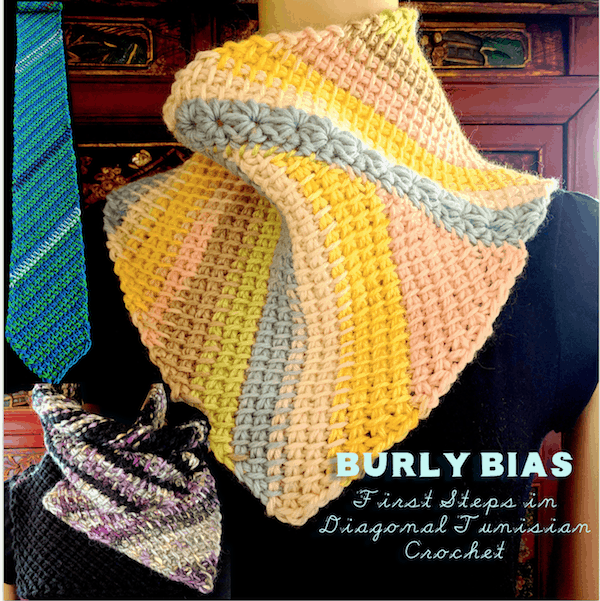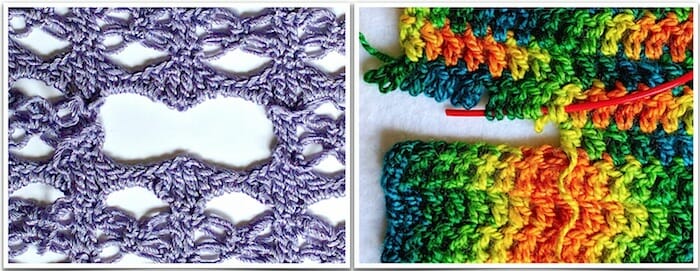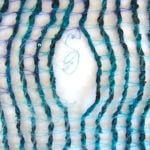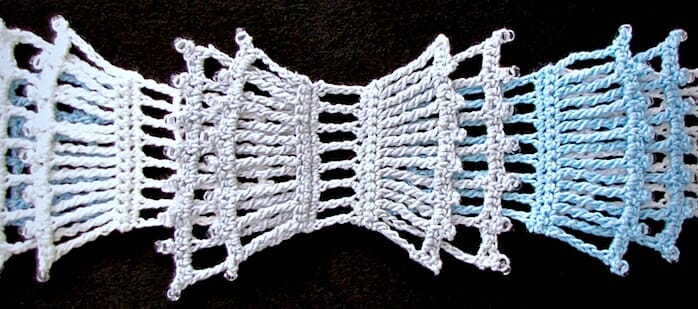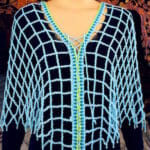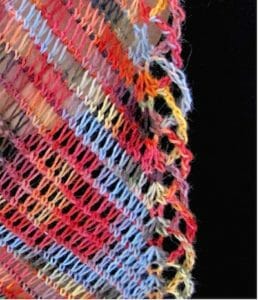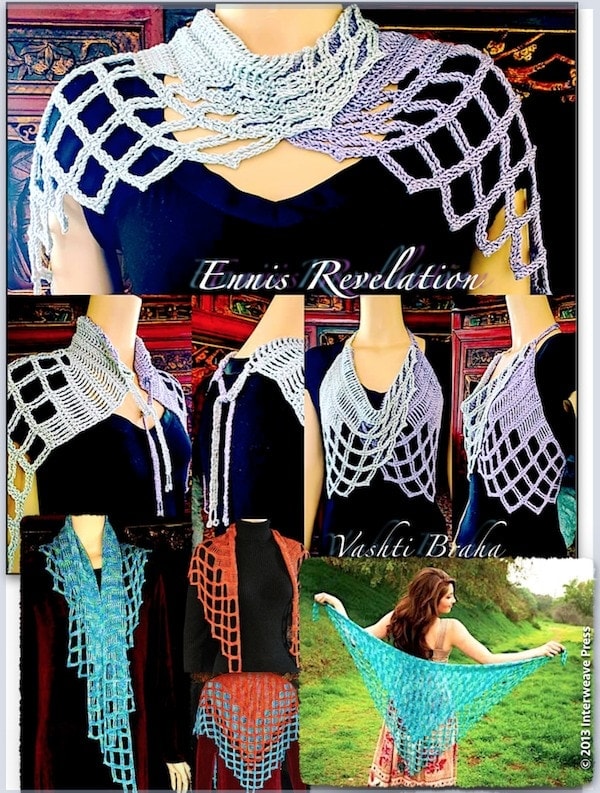
The triangular Ennis shawl in this two-pattern set is my first and most dramatic Tunisian filet design. The four-sided lavender Diamond Ennis is the most recent. Triangular Ennis was originally designed for Interweave Crochet Magazine, Summer 2013 issue.
Also new for this set is a complete stitch diagram, schematics and plenty of extra information—for lefties too.
Back in 2010 I couldn’t find examples of filet lace done with Tunisian crochet. The original Ennis was my confirmation and encouragement—a revelation. I remember the liberating “Yes, it can be done!” feeling. It inspired the Aero series: Aero, Warm Aeroette, Aery Faery, and Aquarienne, as well as more designs, classes, newsletters, and blog posts over the years. I’ve added links to some of these in the patterns.
They’re lovely on both sides, which I find is typical of Tunisian crochet that is very lacy. Another nice feature of Tunisian lace is that it doesn’t eat up yarn. Even the orange one-skein Ennis can be tied around my medium-size waist on a carefree summer day. I used two skeins for the larger blue one, and two of my Lotus Snack mini-balls for Diamond Ennis. The pattern works with any yarn amount and weight.
Skill Level
Tunisian Intermediate. With this pattern you’ll learn how to crochet a triangular shawl side to side (a.k.a. point to point or P2P), and a diamond shape from the center out. You’ll either increase or decrease along only the starting edge of the forward passes. The dramatic filet border is created as you complete each row, so a long-striping yarn would work well for this.
I’ve kept abbreviations to a minimum.
?After using this pattern, you will know (if you didn’t already):
- How to apply principles of filet crochet to Tunisian stitches for a strikingly lacy net.
- How to manage different kinds of loops held on the Tunisian crochet hook: temporary vs. Tunisian yarn overs, and completed stitches.
- How to crochet a triangle shawl by starting and ending at the upper corners.
- How to create a versatile diamond variation using just the gauge swatch.
- How to edge Tunisian crochet with filet spaces as you go.
- How to crochet beaded-fringe removable ties.
Materials & Sizes
Straight or Flexible Tunisian crochet hook at least 13″ {33.0 cm} long: Size G/6 {4 mm} or size needed to match gauge.
Yarn DesigningVashti.com Lotus (52% Cotton, 48% Rayon; 256 yds/235 m per 3.5 oz/100 g skein): use one ball for the smaller orange wrap and 2 balls for the larger blue one. It’s currently available and substitutes perfectly for the (possibly discontinued) orange and blue yarn I used for the original triangle shawls:
- Diamond-Ennis (170–240 yds): 38 (41.5, 45)” {96.5 (105.4, 114.3) cm} long and 12 (13, 14)” {30.5 (33.0, 35.6) cm} wide. For the one shown, I used only 1 (2) balls each of DesigningVashti.com Lotus Snack mini-balls (52% Cotton, 48% Rayon; 85 yds/77.7 m per 1.16 oz/33 g skein), Satin Grey and Lavender Ice.
- Halter Vest: Torso circumference is 38 (41.5, 45)” {96.5 (105.4, 114.3) cm}. Each solid-stitch bra cup section spans approx. 7.5 (8.5, 9.5)” {19.1 (21.6, 24.1) cm} in height and width. Neckline drop is 12 (13, 14.5)”. The ties add range to these final dimensions. Dimensions are given for sizes X-Small/Small, with Medium and Large in parentheses. See p. 9 for customizing the dimensions and yarn amounts.
Shoulder Drape: 38 (41.5, 45)” long x 12 (13, 14.5)” wide {105.4 (114.3) cm x 33.0 (36.8) cm}.
Yarn: Southwest Trading Company Bamboo (100% bamboo; 250 yd [229 m]/3.53 oz [100 g]): 1 (#411 Tequila) or 2 (#128 Ocean Life) skeins, possibly discontinued:
- Two-skein (500 yds) blue shawl: About 62” {157.5 cm} wide from point to point and 25” {63.5 cm} long at deepest point of triangle.
- One-skein (250 yds) orange shoulder wrap: About 50” {127.0 cm} wide from point to point and 20” {50.8 cm} long at deepest point of triangle.
- Substituting: Pattern works the same if you use one color throughout. Choose a yarn with a recommended crochet hook size range of E/4–G/7 {3.5 mm–4.5 mm}. Or use any yarn weight and a hook size that is appropriate for it.
Large Seed Beads and a steel hook (optional for ties): 18 seed beads per tie. Capelet style needs two ties (36 beads) and the halter style needs four (72 beads). The bead holes need to be large enough for a loop of your yarn to be pulled through with a steel crochet hook. For the Lotus yarn I used size 6° “e-beads” and a size 10 {1.3 mm} steel hook.
Notions: Two stitch markers. Scissors. Yarn needle.
